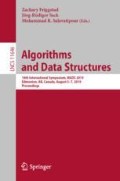Abstract
We give an algorithm to compute a one-dimensional shape-constrained function that best fits given data in weighted-\(L_{\infty }\) norm. We give a single algorithm that works for a variety of commonly studied shape constraints including monotonicity, Lipschitz-continuity and convexity, and more generally, any shape constraint expressible by bounds on first- and/or second-order differences. Our algorithm computes an approximation with additive error \(\epsilon \) in \(O\left( n \log \frac{U}{\epsilon } \right) \) time, where U captures the range of input values. We also give a simple greedy algorithm that runs in O(n) time for the special case of unweighted \(L_{\infty }\) convex regression. These are the first (near-)linear-time algorithms for second-order-constrained function fitting. To achieve these results, we use a novel geometric interpretation of the underlying dynamic programming problem. We further show that a generalization of the corresponding problems to directed acyclic graphs (DAGs) is as difficult as linear programming.
An extended online version with full proofs is available at arxiv.org/abs/1905.02149.
D. Durfee—Supported in part by National Science Foundation Grant 1718533.
S. Wild—Supported by the Natural Sciences and Engineering Research Council of Canada and the Canada Research Chairs Programme.
Access this chapter
Tax calculation will be finalised at checkout
Purchases are for personal use only
Notes
- 1.
Some problems are stated with \(\pm \infty \) values, but we can always replace unbounded values in the algorithms with an (input-specific) sufficiently large finite number.
References
Agarwal, P.K., Phillips, J.M., Sadri, B.: Lipschitz unimodal and isotonic regression on paths and trees. In: López-Ortiz, A. (ed.) LATIN 2010. LNCS, vol. 6034, pp. 384–396. Springer, Heidelberg (2010). https://doi.org/10.1007/978-3-642-12200-2_34
Aggarwal, A., Klawe, M.M., Moran, S., Shor, P., Wilber, R.: Geometric applications of a matrix-searching algorithm. Algorithmica 2(1–4), 195–208 (1987). https://doi.org/10.1007/bf01840359
Bach, F.: Efficient algorithms for non-convex isotonic regression through submodular optimization. In: Bengio, S., Wallach, H., Larochelle, H., Grauman, K., Cesa-Bianchi, N., Garnett, R. (eds.) Advances in Neural Information Processing Systems, vol. 31, pp. 1–10. Curran Associates, Inc. (2018)
Balázs, G.: Convex Regression: Theory, Practice, and Applications. Ph.D. thesis (2016). https://doi.org/10.7939/R3T43J98B
Chazelle, B.: A theorem on polygon cutting with applications. In: Symposium on Foundations of Computer Science (SFCS), pp. 339–349. IEEE (1982). https://doi.org/10.1109/SFCS.1982.58
Eppstein, D., Galil, Z., Giancarlo, R.: Speeding up dynamic programming. In: Symposium on Foundations of Computer Science (SFCS), IEEE (1988). https://doi.org/10.1109/sfcs.1988.21965
Erickson, J.: Shortest homotopic paths (2009). http://jeffe.cs.illinois.edu/teaching/comptop/2009/notes/shortest-homotopic-paths.pdf. lecture notes for computational topology
Fefferman, C.: Smooth interpolation of data by efficient algorithms. In: Excursions in Harmonic Analysis, vol. 1, pp. 71–84. Birkhäuser, Boston, November 2012. https://doi.org/10.1007/978-0-8176-8376-4_4
Fournier, H., Vigneron, A.: Fitting a step function to a point set. Algorithmica 60(1), 95–109 (2009). https://doi.org/10.1007/s00453-009-9342-z
Fournier, H., Vigneron, A.: A deterministic algorithm for fitting a step function to a weighted point-set. Inf. Process. Lett. 113(3), 51–54 (2013). https://doi.org/10.1016/j.ipl.2012.11.003
Galil, Z., Giancarlo, R.: Speeding up dynamic programming with applications to molecular biology. Theor. Comput. Sci. 64(1), 107–118 (1989). https://doi.org/10.1016/0304-3975(89)90101-1
Ganti, R.S., Balzano, L., Willett, R.: Matrix completion under monotonic single index models. In: Cortes, C., Lawrence, N.D., Lee, D.D., Sugiyama, M., Garnett, R. (eds.) Advances in Neural Information Processing Systems, vol. 28, pp. 1873–1881. Curran Associates, Inc. (2015)
Groeneboom, P., Jongbloed, G.: Nonparametric Estimation Under Shape Constraints, vol. 38. Cambridge University Press (2014)
Guntuboyina, A., Sen, B.: Nonparametric shape-restricted regression. Stat. Sci. 33(4), 568–594 (2018). https://doi.org/10.1214/18-sts665
Kakade, S.M., Kanade, V., Shamir, O., Kalai, A.: Efficient learning of generalized linear and single index models with isotonic regression. In: Shawe-Taylor, J., Zemel, R.S., Bartlett, P.L., Pereira, F., Weinberger, K.Q. (eds.) Advances in Neural Information Processing Systems, vol. 24, pp. 927–935. Curran Associates, Inc. (2011)
Kalai, A.T., Sastry, R.: The isotron algorithm: High-dimensional isotonic regression. In: Annual Conference on Learning Theory (COLT) (2009)
Klein, P.N.: Multiple-source shortest paths in planar graphs. In: Symposium on Discrete Algorithms (SODA), pp. 146–155. SIAM (2005)
Kyng, R., Rao, A., Sachdeva, S.: Fast, provable algorithms for isotonic regression in all \(l_p\)-norms. In: Cortes, C., Lawrence, N.D., Lee, D.D., Sugiyama, M., Garnett, R. (eds.) Advances in Neural Information Processing Systems, vol. 28, pp. 2719–2727. Curran Associates, Inc. (2015)
Lee, D.T., Preparata, F.P.: Euclidean shortest paths in the presence of rectilinear barriers. Networks 14(3), 393–410 (1984). https://doi.org/10.1002/net.3230140304
Lim, C.H.: An efficient pruning algorithm for robust isotonic regression. In: Bengio, S., Wallach, H., Larochelle, H., Grauman, K., Cesa-Bianchi, N., Garnett, R. (eds.) Advances in Neural Information Processing Systems, vol. 31, pp. 219–229. Curran Associates, Inc. (2018)
Luss, R., Rosset, S.: Generalized isotonic regression. J. Comput. Graph. Stat. 23(1), 192–210 (2014). https://doi.org/10.1080/10618600.2012.741550
Mazumder, R., Choudhury, A., Iyengar, G., Sen, B.: A computational framework for multivariate convex regression and its variants. J. Am. Stat. Assoc. 1–14 (2018). https://doi.org/10.1080/01621459.2017.1407771
Rote, G.: Isotonic regression by dynamic programming. In: Fineman, J.T., Mitzenmacher, M. (eds.) Symposium on Simplicity in Algorithms (SOSA 2019), OASIcs, vol. 69, pp. 1:1–1:18. Schloss Dagstuhl-Leibniz-Zentrum fuer Informatik (2018). https://doi.org/10.4230/OASIcs.SOSA.2019.1
Stout, Q.F.: Unimodal regression via prefix isotonic regression. Comput. Stat. Data Anal. 53(2), 289–297 (2008). https://doi.org/10.1016/j.csda.2008.08.005
Stout, Q.F.: Fastest isotonic regression algorithms (2014). http://web.eecs.umich.edu/~qstout/IsoRegAlg.pdf
Tsourakakis, C.E., Peng, R., Tsiarli, M.A., Miller, G.L., Schwartz, R.: Approximation algorithms for speeding up dynamic programming and denoising aCGH data. J. Exp. Algorithmics 16, 1 (2011). https://doi.org/10.1145/1963190.2063517
Yao, F.F.: Efficient dynamic programming using quadrangle inequalities. In: Symposium on Theory of Computing (STOC). ACM Press (1980). https://doi.org/10.1145/800141.804691
Yao, F.F.: Speed-up in dynamic programming. SIAM J. Algebraic Discrete Methods 3(4), 532–540 (1982). https://doi.org/10.1137/0603055
Acknowledgments
We thank Richard Peng, Sushant Sachdeva, and Danny Sleator for insightful discussions, and our anonymous referees for further relevant references and insightful comments that significantly improved the presentation.
Author information
Authors and Affiliations
Corresponding author
Editor information
Editors and Affiliations
Rights and permissions
Copyright information
© 2019 Springer Nature Switzerland AG
About this paper
Cite this paper
Durfee, D., Gao, Y., Rao, A.B., Wild, S. (2019). Efficient Second-Order Shape-Constrained Function Fitting. In: Friggstad, Z., Sack, JR., Salavatipour, M. (eds) Algorithms and Data Structures. WADS 2019. Lecture Notes in Computer Science(), vol 11646. Springer, Cham. https://doi.org/10.1007/978-3-030-24766-9_29
Download citation
DOI: https://doi.org/10.1007/978-3-030-24766-9_29
Published:
Publisher Name: Springer, Cham
Print ISBN: 978-3-030-24765-2
Online ISBN: 978-3-030-24766-9
eBook Packages: Computer ScienceComputer Science (R0)

